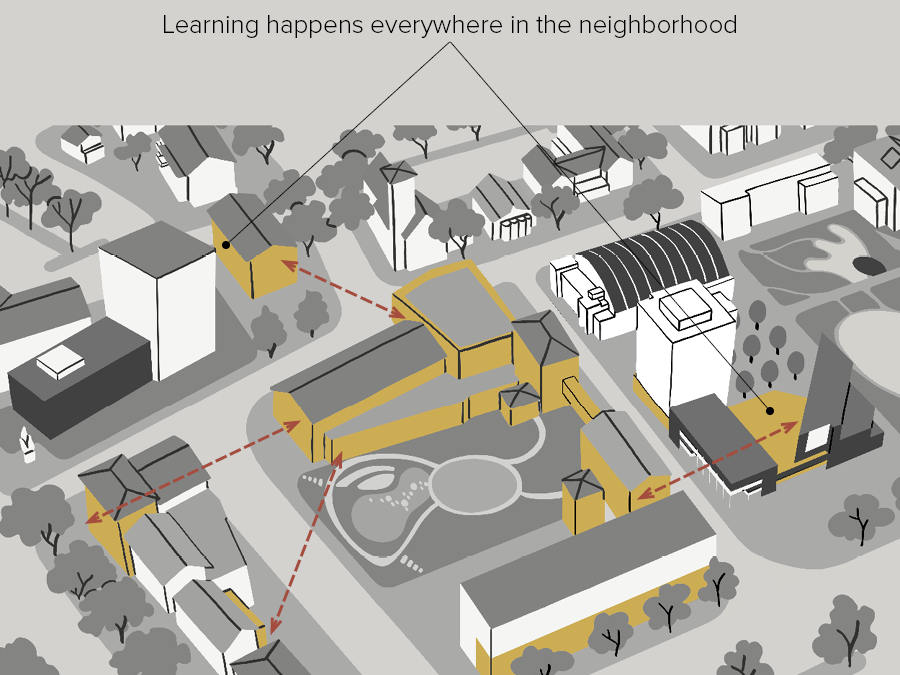Learning In Community–What Does it Look Like?
Key Points
-
Neighborhood as School Design Pattern aims to make learning more authentic, relevant, and community-connected.
-
If communities are willing to rethink when, where, and how learning happens, they will find many of the spaces for learning already exist.
-
This builds on the emerging ecosystem work being led by Education Reimagined.

What does learning spread across a community look like?
When the whole neighborhood is the school, we can see learning happening everywhere, including homes, libraries, school buildings, offices, health clubs, museums, community gardens, retirement homes and parks, to name a few.
In its description of community-based learning ecosystems, Education Reimagined describes the dynamic possibilities when neighborhoods function as schools. An ever-evolving web of relationships sparks student curiosity and provides opportunities for learners, businesses and community organizations to identify and solve problems together. While every community includes opportunities for connected learning, the relationships needed to function as an integrated whole are often missing or need strengthening.
Education Reimagined notes that there is no finish line in this work and asks us to imagine how we can transform our own communities. Using my own lens as an architect and global traveler, I can offer some insights into the physical environments best-suited for neighborhoods that serve as schools.
We chose a sketch of a traditional town square as our key pattern image because the character, scale and interrelationships between buildings illustrate the pattern of a thriving neighborhood. Whether it’s a traditional European city or a Disney theme park, millions of people each year enjoy the sense of connection and power of place offered by walkable, human-scaled environments. When learning ecosystems place high value on community connections, a natural benefit is more “eyes on the street,” (a term coined by Jane Jacobs in The Death and Life of the Great American City) a pivotal concept in safe neighborhoods.
A key principle in this human-centered approach to design is the celebration of public space, including the space between buildings. The sense of beauty and well-being that we feel in a town square or piazza is not limited to any individual building–rather, it’s based on the dynamic interconnections between buildings, sidewalks, streets, parks, trees, and people–we experience the space and place as a beautiful whole. Leveraging Neighborhood as School connects learning to this beautiful whole, immediately adding authenticity and purpose to the learner’s experience.
Leveraging Neighborhood as School connects learning to a beautiful whole, immediately adding authenticity and purpose to the learner’s experience.
Randy Fielding
While human-centered, neighborhood-scale design is a beautiful aspiration for any community, for low-income, racialized communities with housing and food insecurity, an integrated approach to neighborhood design is both aspirational and an essential step towards wholeness.
Case-study in Progress
We can see a small step in this direction in a sketch that I created for High School for Recording Arts, in St. Paul, Minnesota (affectionately known as Hip Hop Hi, a nickname that I gave them during our first project together in 2001).
In the sketch below, you can see the school on the lower left, which includes Studio 4, a commercial recording studio. On the right, you’ll find the proposed impact hub, which includes Diverse Media Institute (DMI), a media arts college, an entrepreneurship hub, where businesses and students work together, and a retail incubator space that supports mentorships, innovation, and real-world experience for students.
The impact hub offers reciprocal benefits–not only to learners but in offering businesses access to brilliant, creative youth talent.
Breaking bread together anchors a community, and in support of that universal principle, a restaurant is included. Staffed in partnership with DMI’s culinary arts program, the restaurant faces both University Ave, a main commercial street in St. Paul, as well as the central green. The restaurant supports student education, and employment, while reinforcing the project as a center of a walkable neighborhood.
The impact hub, DMI, retail incubator, and restaurant mean that there will be people with “eyes on street” day and night, a major asset to the local community.
Together, each of these components form a neighborhood where living, learning and business spaces create a holistic ecosystem, and the whole is greater than the sum of its parts. The benefits include safe residences for housing insecure students, multi-general connections and inspiration for artists, businesses and learners, employment opportunities, and safer streets.
How might we apply these principles to embed learning throughout our communities? Who would benefit if this were common in our schools today?







0 Comments
Leave a Comment
Your email address will not be published. All fields are required.